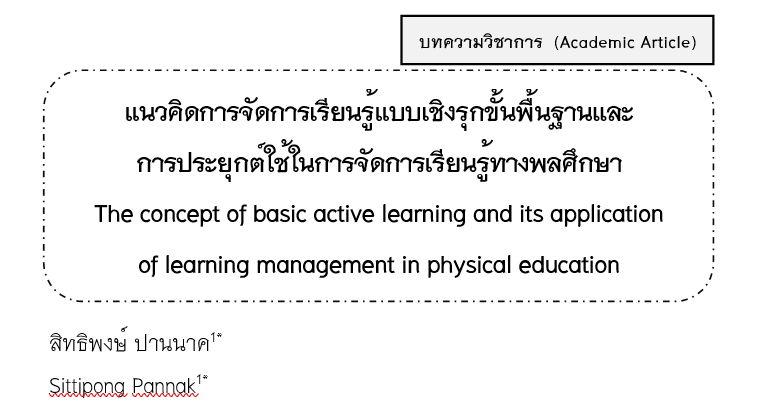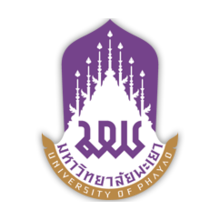The Concept of Basic Active Learning and Its Application of Learning Management in Physical Education
Keywords:
Active learning, Basic active learning, Learning management in physical educationAbstract
This article aimed to present the synthetic results of the active learning approach to basic active learning processes for physical education. Basic active learning can be divided into 6 components as follows: 1) Learning content descriptions are comprehensive and concise time. 2) Dividing learners into groups. 3) Defining problems or questions in learning. 4) Studying, researching, and participating in learners' practice. 5) Stimulating and promoting individual learners' aptitudes or abilities, and 6) Collaborative learning discussion in the classroom. According to the active learning approach, physical education teachers can apply this to be appropriate in accordance with the context of the sport, the number of learners, teaching grade level, and the availability of media, materials, and equipment including techniques and advanced skills for designing learning activities according to the principles and sequence of steps in the physical education in order to organize those learning activities effectively and benefit the development of learners to their full potential.
References
กระทรวงศึกษาธิการ. (2562). แนวทางการนิเทศเพื่อพัฒนาและส่งเสริมการจัดการเรียนรู้เชิงรุก (Active Learning) ตามนโยบายลดเวลาเรียน เพิ่มเวลารู้. สืบค้น 18 ตุลาคม 2564, จาก http://academic.obec.go.th/images/document/1603180137_d_1.pdf.
นันทรัตน์ ศรีสวัสดิ์. (2560). แนวทางการพัฒนาการสอนกีฬาบาสเกตบอล ตามกระบวนการสอนแบบการเรียนรู้เชิงรุก. (วิทยานิพนธ์ วิทยาศาสตรมหาบัณฑิต สาขาวิชาวิทยาศาสตร์การออกกำลังกายและการกีฬา). ชลบุรี: มหาวิทยาลัยบูรพา.
ปรียานุช พรหมภาษิต. (2558). คู่มือการจัดการเรียนรู้. กำแพงเพชร: คณะมนุษยศาสตร์และสังคมศาสตร์ มหาวิทยาลัยราชภัฎกำแพงเพชร.
วรศักดิ์ เพียรชอบ. (2561). รวมบทความเกี่ยวกับปรัชญา หลักการ วิธีสอน และการวัด เพื่อประเมินผลทางการศึกษา. กรุงเทพฯ: สำนักพิมพ์แห่งจุฬาลงกรณ์มหาวิทยาลัย.
วารินทร์พร ฟันเฟื่องฟู. (2562). การจัดการเรียนรู้ Active Learning ให้สำเร็จ. วารสารวไลยอลงกรณ์ปริทัศน์ (มนุษยศาสตร์และสังคมศาสตร์), 9(1), 135-145.
ศักดิ์ศรี ปาณะกุล. (2556). หลักสูตรละการจัดการเรียนรู้. กรุงเทพฯ: สำนักพิมพ์มหาวิทยาลัยรามคำแหง.
Felder, R.M. (2015). Active Learning: An Introduction. Retrieved October 18, 2020, from https://www.researchgate.net/publication/242102584.pdf.
Romanow, D. (2020). Using Active Learning, Group Formation, and Discussion to Increase Student Learning: A Business Intelligence Skills Analysis. Journal of Information Systems Education, 31(3), 218-231.
Smith, A.D., et al. (2020). Implementing Physically Active Learning: Future Directions for Research, Policy, and Practice. Journal of Sports and Health Science, 9(1), 41-49.
University of Toronto. (2015). Active Learning and Adapting Teaching Techniques. Retrieved October 18, 2020, from https://tatp.utoronto.ca/wp-content/uploads/sites/2/Active-Learning-and-Adapting-Teaching-Techniques_TATP1.pdf.

Downloads
Published
How to Cite
Issue
Section
License
Copyright (c) 2022 Phayao University

This work is licensed under a Creative Commons Attribution-NonCommercial-NoDerivatives 4.0 International License.
ผู้นิพนธ์ต้องรับผิดชอบข้อความในบทนิพนธ์ของตน มหาวิทยาลัยพะเยาไม่จำเป็นต้องเห็นด้วยกับบทความที่ตีพิมพ์เสมอไป ผู้สนใจสามารถคัดลอก และนำไปใช้ได้ แต่จะต้องขออนุมัติเจ้าของ และได้รับการอนุมัติเป็นลายลักษณ์อักษรก่อน พร้อมกับมีการอ้างอิงและกล่าวคำขอบคุณให้ถูกต้องด้วย
The authors are themselves responsible for their contents. Signed articles may not always reflect the opinion of University of Phayao. The articles can be reproduced and reprinted, provided that permission is given by the authors and acknowledgement must be given.







